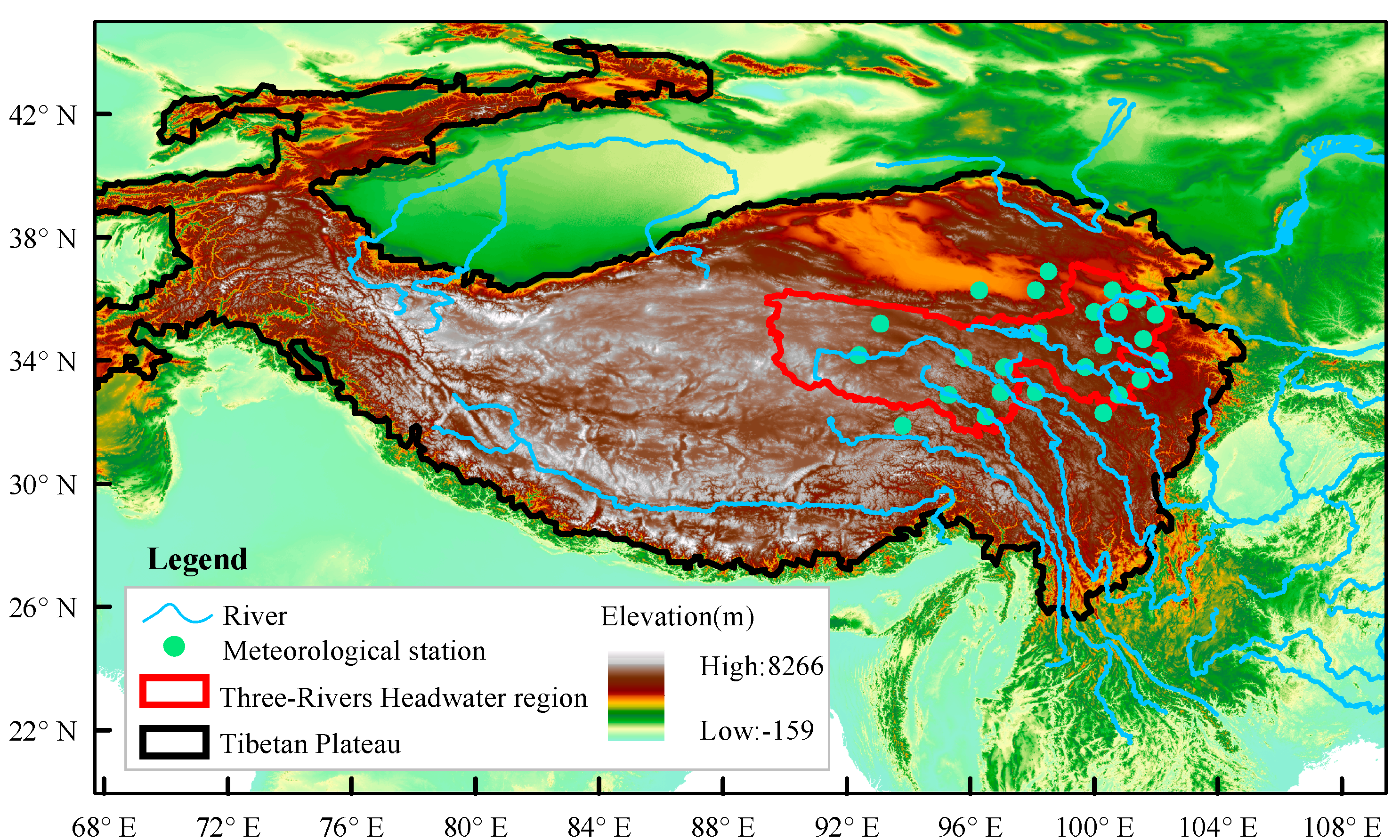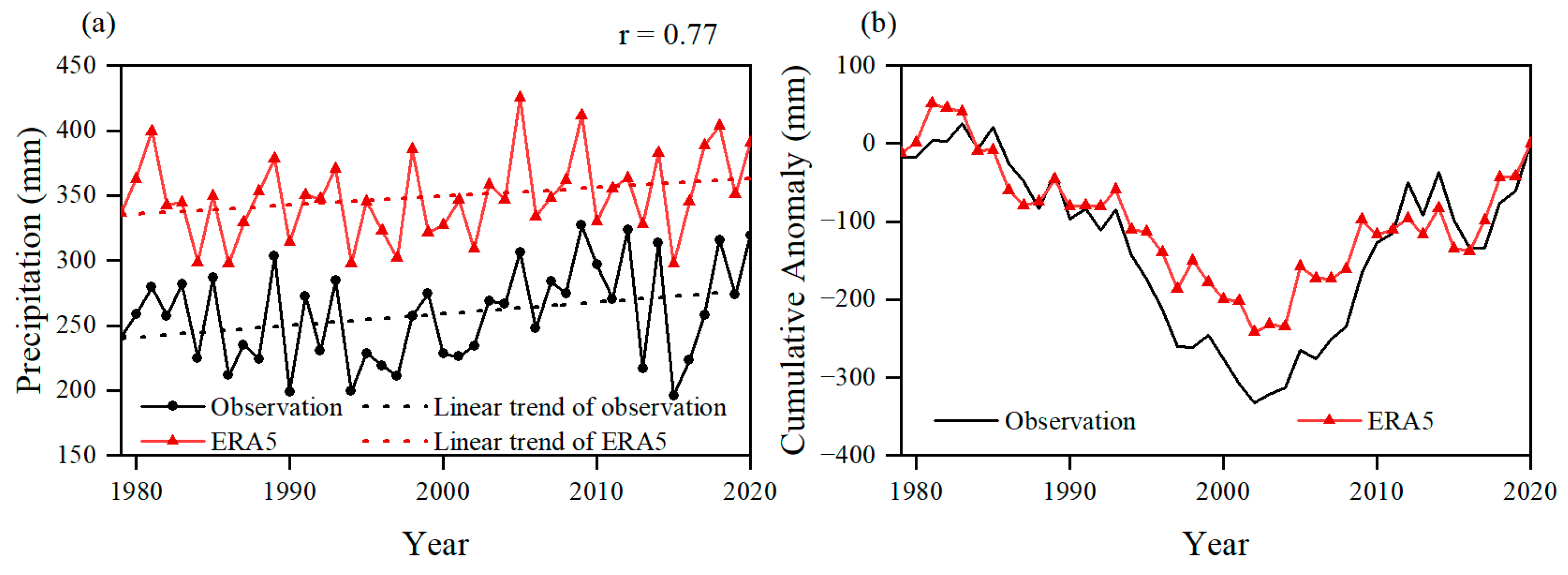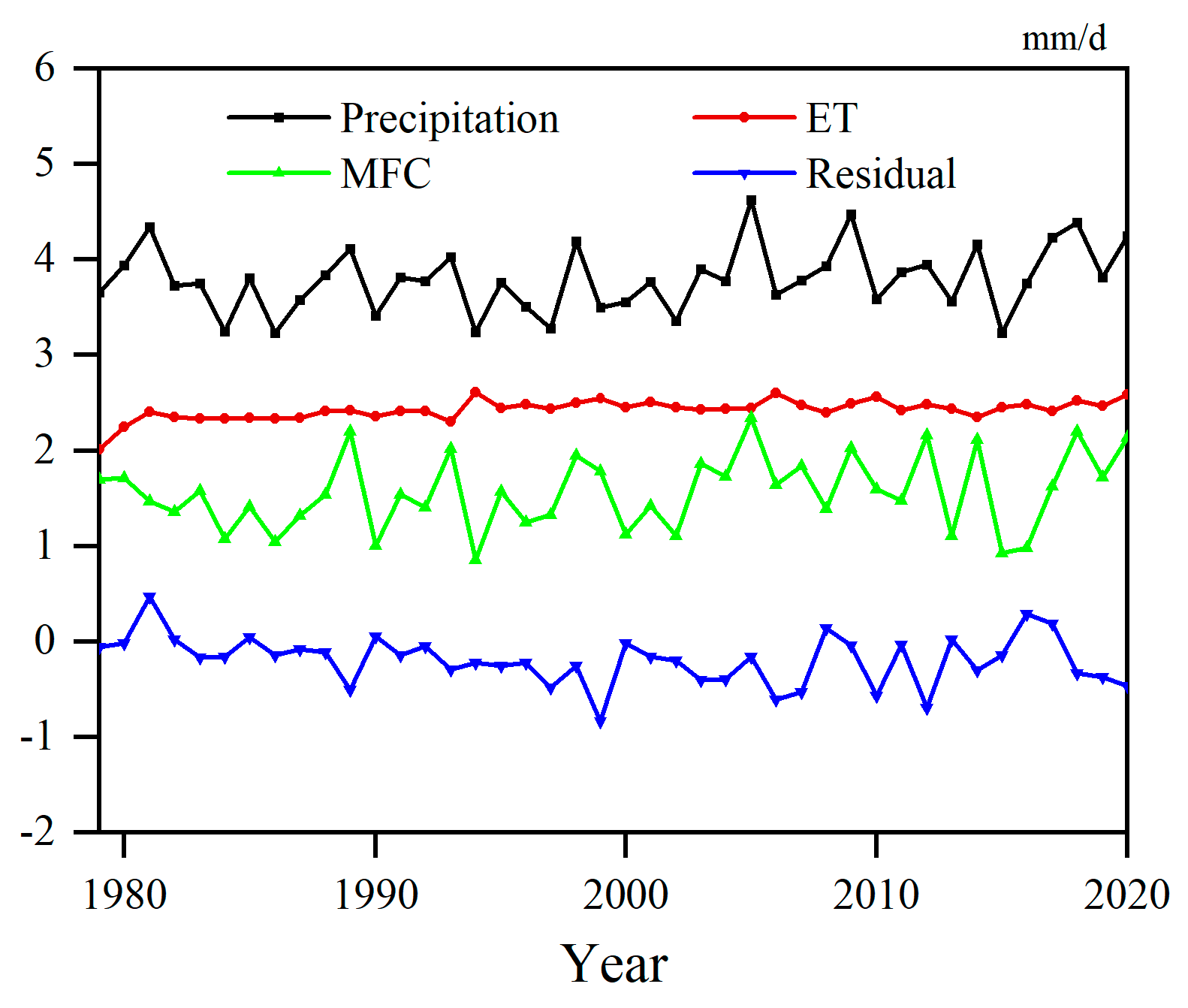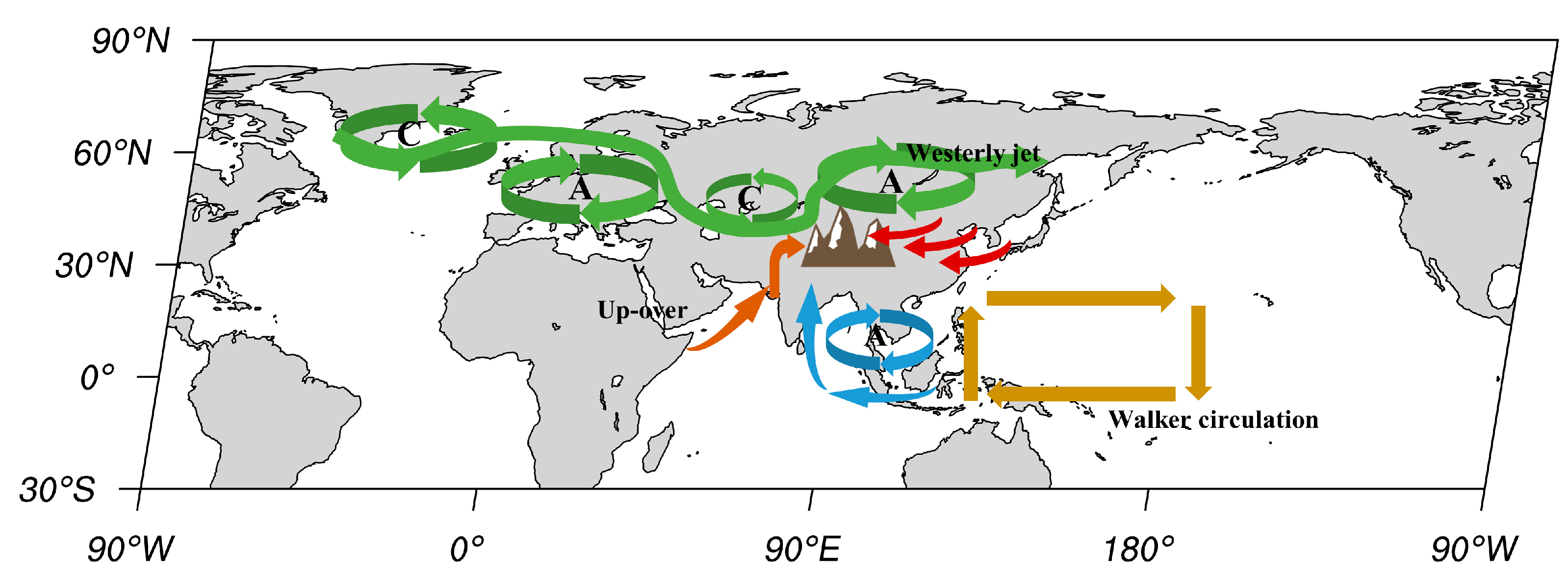Understanding the Dry-to-Wet Transition of Summer Precipitation over the Three-Rivers Headwater Region: Atmospheric Circulation Mechanisms
Abstract
:1. Introduction
2. Datasets and Methods
2.1. Datasets
2.2. Methods
3. Results
3.1. Interdecadal Variation in Summer Precipitation
3.2. Atmospheric Water Budget
3.3. Associated Atmospheric Circulations
4. Discussion and Conclusions
Author Contributions
Funding
Institutional Review Board Statement
Informed Consent Statement
Data Availability Statement
Conflicts of Interest
References
- Zhang, Y.; Zhang, S.; Zhai, X.; Xia, J. Runoff Variation and Its Response to Climate Change in the Three Rivers Source Region. J. Geogr. Sci. 2012, 22, 781–794. [Google Scholar] [CrossRef]
- Xu, X.; Dong, L.; Zhao, Y.; Wang, Y. Effect of the Asian Water Tower over the Qinghai-Tibet Plateau and the characteristics of atmospheric water circulation (in Chinese). Chin. Sci. Bull. 2019, 64, 2830–2841. [Google Scholar] [CrossRef]
- Liu, X.; Zhang, J.; Zhu, X.; Pan, Y.; Liu, Y.; Zhang, D.; Lin, Z. Spatiotemporal Changes in Vegetation Coverage and Its Driving Factors in the Three-River Headwaters Region during 2000–2011. J. Geogr. Sci. 2014, 24, 288–302. [Google Scholar] [CrossRef]
- Zheng, Y.; Han, J.; Huang, Y.; Fassnacht, S.R.; Xie, S.; Lv, E.; Chen, M. Vegetation Response to Climate Conditions Based on NDVI Simulations Using Stepwise Cluster Analysis for the Three-River Headwaters Region of China. Ecol. Indic. 2018, 92, 18–29. [Google Scholar] [CrossRef]
- Bai, Y.; Guo, C.; Degen, A.A.; Ahmad, A.A.; Wang, W.; Zhang, T.; Li, W.; Ma, L.; Huang, M.; Zeng, H.; et al. Climate Warming Benefits Alpine Vegetation Growth in Three-River Headwater Region, China. Sci. Total Environ. 2020, 742, 140574. [Google Scholar] [CrossRef] [PubMed]
- Olmedo, E.; Turiel, A.; González-Gambau, V.; González-Haro, C.; García-Espriu, A.; Gabarró, C.; Portabella, M.; Corbella, I.; Martín-Neira, M.; Arias, M.; et al. Increasing Stratification as Observed by Satellite Sea Surface Salinity Measurements. Sci. Rep. 2022, 12, 6279. [Google Scholar] [CrossRef] [PubMed]
- Yu, L.; Josey, S.A.; Bingham, F.M.; Lee, T. Intensification of the Global Water Cycle and Evidence from Ocean Salinity: A Synthesis Review. Ann. New York Acad. Sci. 2020, 1472, 76–94. [Google Scholar] [CrossRef] [PubMed]
- Kukulies, J.; Lai, H.-W.; Curio, J.; Feng, Z.; Lin, C.; Li, P.; Ou, T.; Sugimoto, S.; Chen, D. Mesoscale Convective Systems in the Third Pole Region: Characteristics, Mechanisms and Impact on Precipitation. Front. Earth Sci. 2023, 11, 1143380. [Google Scholar] [CrossRef]
- Yi, X.; Li, G.; Yin, Y. Spatio-Temporal Variation of Precipitation in the Three-River Headwater Region from 1961 to 2010. J. Geogr. Sci. 2013, 23, 447–464. [Google Scholar] [CrossRef]
- Xi, Y.; Miao, C.; Wu, J.; Duan, Q.; Lei, X.; Li, H. Spatiotemporal Changes in Extreme Temperature and Precipitation Events in the Three-Rivers Headwater Region, China. J. Geophys. Res. Atmos. 2018, 123, 5827–5844. [Google Scholar] [CrossRef]
- De Oliveira, V.A.; de Mello, C.R.; Viola, M.R.; Srinivasan, R. Assessment of Climate Change Impacts on Streamflow and Hydropower Potential in the Headwater Region of the Grande River Basin, Southeastern Brazil. Int. J. Climatol. 2017, 37, 5005–5023. [Google Scholar] [CrossRef]
- Yao, T.; Piao, S.; Shen, M.; Gao, J.; Yang, W.; Zhang, G.; Lei, Y.; Gao, Y.; Zhu, L.; Xu, B.; et al. Chained Impacts on Modern Environment of Interaction between Westerlies and Indian Monsoon on Tibetan Plateau. China Acad. J. Electron. Publ. House 2017, 32, 976–984. [Google Scholar] [CrossRef]
- Shi, H.; Li, T.; Wei, J.; Fu, W.; Wang, G. Spatial and Temporal Characteristics of Precipitation over the Three-River Headwaters Region during 1961–2014. J. Hydrol. Reg. Stud. 2016, 6, 52–65. [Google Scholar] [CrossRef]
- Sun, J.; Yang, K.; Guo, W.; Wang, Y.; He, J.; Lu, H. Why Has the Inner Tibetan Plateau Become Wetter since the Mid-1990s? J. Clim. 2020, 33, 8507–8522. [Google Scholar] [CrossRef]
- Liu, X.; Yang, M.-X.; Dong, N.-P.; Xie, W.-N.; Li, H.-G.; Guan, Z.; Wen, F.; Wang, H.; Chen, D. Increased Southerly and Easterly Water Vapor Transport Contributed to the Dry-to-Wet Transition of Summer Precipitation over the Three-River Headwaters in the Tibetan Plateau. Adv. Clim. Change Res. 2023, 14, 502–510. [Google Scholar] [CrossRef]
- Sun, B.; Wang, H. Interannual Variation of the Spring and Summer Precipitation over the Three River Source Region in China and the Associated Regimes. J. Clim. 2018, 31, 7441–7457. [Google Scholar] [CrossRef]
- Li, Z.; Lyu, S.; Chen, H.; Ao, Y.; Zhao, L.; Wang, S.; Zhang, S.; Meng, X. Changes in Climate and Snow Cover and Their Synergistic Influence on Spring Runoff in the Source Region of the Yellow River. Sci. Total Environ. 2021, 799, 149503. [Google Scholar] [CrossRef] [PubMed]
- Yi, W.; Feng, Y.; Liang, S.; Kuang, X.; Yan, D.; Wan, L. Increasing Annual Streamflow and Groundwater Storage in Response to Climate Warming in the Yangtze River Source Region. Environ. Res. Lett. 2021, 16, 084011. [Google Scholar] [CrossRef]
- Dong, N.; Wei, J.; Yang, M.; Yan, D.; Yang, C.; Gao, H.; Arnault, J.; Laux, P.; Zhang, X.; Liu, Y.; et al. Model Estimates of China’s Terrestrial Water Storage Variation Due To Reservoir Operation. Water Resour. Res. 2022, 58, e2021WR031787. [Google Scholar] [CrossRef]
- Li, S.; Yao, Z.; Wang, R.; Liu, Z. Dryness/Wetness Pattern over the Three-River Headwater Region: Variation Characteristic, Causes, and Drought Risks. Int. J. Clim. 2020, 40, 3550–3566. [Google Scholar] [CrossRef]
- Jiang, C.; Zhang, L. Ecosystem Change Assessment in the Three-River Headwater Region, China: Patterns, Causes, and Implications. Ecol. Eng. 2016, 93, 24–36. [Google Scholar] [CrossRef]
- Gustafsson, M.; Rayner, D.; Chen, D. Extreme Rainfall Events in Southern Sweden: Where Does the Moisture Come From? Tellus A Dyn. Meteorol. Oceanogr. 2010, 62, 605–616. [Google Scholar] [CrossRef]
- Chen, F.; Avissar, R. Impact of Land-Surface Moisture Variability on Local Shallow Convective Cumulus and Precipitation in Large-Scale Models. J. Appl. Meteorol. 1994, 33, 1382–1401. [Google Scholar] [CrossRef]
- Yao, T.; Bolch, T.; Chen, D.; Gao, J.; Immerzeel, W.; Piao, S.; Su, F.; Thompson, L.; Wada, Y.; Wang, L.; et al. The Imbalance of the Asian Water Tower. Nat. Rev. Earth Environ. 2022, 3, 618–632. [Google Scholar] [CrossRef]
- Wang, K.L.; Jiang, H.; Zhao, H.Y. Atmospheric Water Vapor Transport from Westerly and Monsoon over the Northwest China. Adv. Water Sci. 2005, 16, 432–438. [Google Scholar]
- Yan, H.; Huang, J.; He, Y.; Liu, Y.; Wang, T.; Li, J. Atmospheric Water Vapor Budget and Its Long-Term Trend Over the Tibetan Plateau. J. Geophys. Res. Atmos. 2020, 125, e2020JD033297. [Google Scholar] [CrossRef]
- Seager, R.; Naik, N.; Vecchi, G.A. Thermodynamic and Dynamic Mechanisms for Large-Scale Changes in the Hydrological Cycle in Response to Global Warming*. J. Clim. 2010, 23, 4651–4668. [Google Scholar] [CrossRef]
- Boos, W.; Kuang, Z. Dominant control of the South Asian monsoon by orographic insulation versus plateau heating. Nature 2010, 463, 218–222. [Google Scholar] [CrossRef]
- Yanai, M.; Tomita, T. Seasonal and Interannual Variability of Atmospheric Heat Sources and Moisture Sinks as Determined from NCEP–NCAR Reanalysis. J. Clim. 1998, 11, 463–482. [Google Scholar] [CrossRef]
- Sugimoto, S.; Ueno, K. Formation of Mesoscale Convective Systems over the Eastern Tibetan Plateau Affected by Plateau-Scale Heating Contrasts. J. Geophys. Res. 2010, 115, D16105. [Google Scholar] [CrossRef]
- Shang, S.; Zhu, G.; Wei, J.; Li, Y.; Zhang, K.; Li, R.; Arnault, J.; Zhang, Z.; Laux, P.; Yang, Q.; et al. Associated Atmospheric Mechanisms for the Increased Cold Season Precipitation over the Three-River Headwaters Region from the Late 1980s. J. Clim. 2021, 34, 8033–8046. [Google Scholar] [CrossRef]
- Sun, B.; Wang, H. Enhanced Connections between Summer Precipitation over the Three-River-Source Region of China and the Global Climate System. Clim. Dyn. 2019, 52, 3471–3488. [Google Scholar] [CrossRef]
- Hersbach, H.; Bell, B.; Berrisford, P.; Biavati, G.; Horányi, A.; Muñoz Sabater, J.; Nicolas, J.; Peubey, C.; Radu, R.; Rozum, I.; et al. ERA5 Monthly Averaged Data on Pressure Levels from 1940 to Present. Copernicus Climate Change Service (C3S) Climate Data Store (CDS). 2023. Available online: https://cds.climate.copernicus.eu/cdsapp#!/dataset/10.24381/cds.6860a573?tab=overview (accessed on 1 July 2023).
- Martens, B.; Miralles, D.G.; Lievens, H.; van der Schalie, R.; de Jeu, R.A.M.; Fernández-Prieto, D.; Beck, H.E.; Dorigo, W.A.; Verhoest, N.E.C. GLEAM v3: Satellite-Based Land Evaporation and Root-Zone Soil Moisture. Geosci. Model. Dev. 2017, 10, 1903–1925. [Google Scholar] [CrossRef]
- Seager, R.; Henderson, N. Diagnostic Computation of Moisture Budgets in the ERA-Interim Reanalysis with Ref-erence to Analysis of CMIP-Archived Atmospheric Model Data. J. Clim. 2013, 26, 7876–7901. [Google Scholar] [CrossRef]
- Trenberth, K.E.; Guillemot, C.J. Evaluation of the Atmospheric Moisture and Hydrological Cycle in the NCEP/NCAR Reanalyses. Clim. Dyn. 1998, 14, 213–231. [Google Scholar] [CrossRef]
- Trenberth, K.E.; Guillemot, C.J. Evaluation of the global atmospheric moisture budget as seen from analyses. J. Clim. 1995, 8, 2255–2272. [Google Scholar] [CrossRef]
- Brubaker, K.L.; Entekhabi, D.; Eagleson, P.S. Estimation of Continental Precipitation Recycling. J. Clim. 1993, 6, 1077–1089. [Google Scholar] [CrossRef]
- Li, L.; Li, W.; Barros, A.P. Atmospheric Moisture Budget and Its Regulation of the Summer Precipitation Variability over the Southeastern United States. Clim. Dyn. 2013, 41, 613–631. [Google Scholar] [CrossRef]
- Dee, D.P.; Uppala, S.M.; Simmons, A.J.; Berrisford, P.; Poli, P.; Kobayashi, S.; Andrae, U.; Balmaseda, M.A.; Balsamo, G.; Bauer, P.; et al. The ERA-Interim Reanalysis: Configuration and Performance of the Data Assimilation System. Q. J. R. Meteorol. Soc. 2011, 137, 553–597. [Google Scholar] [CrossRef]
- Zhang, Y.; Huang, W.; Zhong, D. Major Moisture Pathways and Their Importance to Rainy Season Precipitation over the Sanjiangyuan Region of the Tibetan Plateau. J. Clim. 2019, 32, 6837–6857. [Google Scholar] [CrossRef]
- Gao, Y.; Leung, L.R.; Zhang, Y.; Cuo, L. Changes in Moisture Flux over the Tibetan Plateau during 1979–2011: Insights from a High-Resolution Simulation. J. Clim. 2015, 28, 4185–4197. [Google Scholar] [CrossRef]
- Wang, Z.; Duan, A.; Wu, G. Time-Lagged Impact of Spring Sensible Heat over the Tibetan Plateau on the Summer Rainfall Anomaly in East China: Case Studies Using the WRF Model. Clim. Dyn. 2014, 42, 2885–2898. [Google Scholar] [CrossRef]
- Wang, Z.; Yang, S.; Luo, H.; Li, J. Drying Tendency over the Southern Slope of the Tibetan Plateau in Recent Decades: Role of a CGT-like Atmospheric Change. Clim. Dyn. 2022, 59, 2801–2813. [Google Scholar] [CrossRef]
- Ma, S.; Zhou, T. Robust Strengthening and Westward Shift of the Tropical Pacific Walker Circulation during 1979–2012: A Comparison of 7 Sets of Reanalysis Data and 26 CMIP5 Models. J. Clim. 2016, 29, 3097–3118. [Google Scholar] [CrossRef]
- Dong, W.; Lin, Y.; Wright, J.S.; Ming, Y.; Xie, Y.; Wang, B.; Luo, Y.; Huang, W.; Huang, J.; Wang, L.; et al. Summer Rainfall over the Southwestern Tibetan Plateau Controlled by Deep Convection over the Indian Subcontinent. Nat. Commun. 2016, 7, 10925. [Google Scholar] [CrossRef] [PubMed]












Disclaimer/Publisher’s Note: The statements, opinions and data contained in all publications are solely those of the individual author(s) and contributor(s) and not of MDPI and/or the editor(s). MDPI and/or the editor(s) disclaim responsibility for any injury to people or property resulting from any ideas, methods, instructions or products referred to in the content. |
© 2024 by the authors. Licensee MDPI, Basel, Switzerland. This article is an open access article distributed under the terms and conditions of the Creative Commons Attribution (CC BY) license (https://creativecommons.org/licenses/by/4.0/).
Share and Cite
Liu, X.; Yang, M.; Zhou, F.; Wen, F.; Zhang, X.; Gao, C.; Wang, H.; Dong, N. Understanding the Dry-to-Wet Transition of Summer Precipitation over the Three-Rivers Headwater Region: Atmospheric Circulation Mechanisms. Sustainability 2024, 16, 6299. https://doi.org/10.3390/su16156299
Liu X, Yang M, Zhou F, Wen F, Zhang X, Gao C, Wang H, Dong N. Understanding the Dry-to-Wet Transition of Summer Precipitation over the Three-Rivers Headwater Region: Atmospheric Circulation Mechanisms. Sustainability. 2024; 16(15):6299. https://doi.org/10.3390/su16156299
Chicago/Turabian StyleLiu, Xuan, Mingxiang Yang, Feng Zhou, Fan Wen, Xiaotan Zhang, Chao Gao, Hejia Wang, and Ningpeng Dong. 2024. "Understanding the Dry-to-Wet Transition of Summer Precipitation over the Three-Rivers Headwater Region: Atmospheric Circulation Mechanisms" Sustainability 16, no. 15: 6299. https://doi.org/10.3390/su16156299





